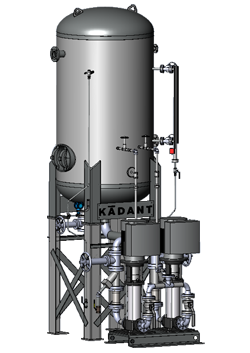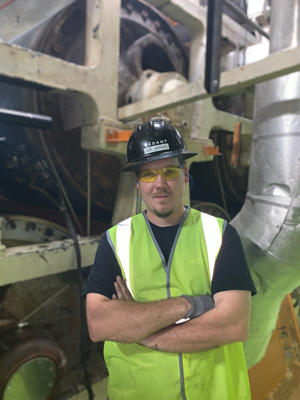Pressure Vessel Quality is More Than Skin Deep – NDT Inspectors Share Their Insights
 Every pressure vessel sold in the United States, whether it is on a high-pressure condensate receiver (pictured) or deaerator tank, must meet minimum safety standards. Beyond the minimum safety standards, the quality and durability of these tanks is determined by the design, materials, method of construction, and application. Kadant Johnson’s Joe Jarvis, ASNT NDT level III, and Mark Bays, NDT services manager, have conducted inspections and nondestructive testing (NDT) on thousands of pressure vessels in the pulp and paper and corrugated packaging industries. From their experience, they share the top five design elements to look for when selecting a pressure vessel.
Every pressure vessel sold in the United States, whether it is on a high-pressure condensate receiver (pictured) or deaerator tank, must meet minimum safety standards. Beyond the minimum safety standards, the quality and durability of these tanks is determined by the design, materials, method of construction, and application. Kadant Johnson’s Joe Jarvis, ASNT NDT level III, and Mark Bays, NDT services manager, have conducted inspections and nondestructive testing (NDT) on thousands of pressure vessels in the pulp and paper and corrugated packaging industries. From their experience, they share the top five design elements to look for when selecting a pressure vessel.
- Baffling directs fluid flow and prevents interior tank erosion. It should be a part of the design process but is often not considered. “Nozzles can direct the fluid velocity at the tank wall, causing impingement,” commented Mark. “If not redirected with baffles, the concentrated erosion will ruin the tank. We had a case where a pressure vessel had to be prematurely replaced in only three years of use.”
- Extra corrosion allowance or thicker walls allow for more wear due to chemical corrosion and erosion from fluid flows. “Tanks are specified to a minimum thickness standard, but often the design engineers don’t consider the corrosiveness of the application or how fluid and injected chemicals are flowing into the tank,” shared Joe. “We recommend adding additional corrosion allowance or exploring additional guidelines (such as Heat Exchange Institute) that better factor in corrosion mechanisms when determining wall thickness and vessel material selection.”
- Heat-treated welds add extra strength and relieve the built-up stresses in the welds and surrounding wall material. Mark commented, “We’ve inspected tanks with cracks every few inches, and those tanks had to be replaced. All the cracks were transverse to the weld. Likely due to thermal cycling of the pressure vessel accelerated by a corrosive environment. Post-weld heat treatment (PWHT) would have given the welds the strength they needed for thermal cycling.”
- Removal of backing strips after fabrication allows interior weld inspections and prevents contamination buildup. “Backing strips are tack welded inside the tank and are used as a backstop when welding single-penetration seams. They are often left in the tank to avoid the cost of removal,” shared Mark Bays. “This prevents us from magnetic particle testing or visually inspecting interior welds. They can also act as a ledge on the inside of the vessel; trapping material and accelerating corrosion fatigue.”
- Inspection ports are essential so the inside of small tanks can be accessed and inspected, but often standards do not require inspection ports on pressure vessels under 36” in diameter. As Joe simply stated, “If we can’t access it, we can’t inspect it.”
 Joe Jarvis, ASNT NDT level III
Joe Jarvis, ASNT NDT level III Mark Bays, NDT services manager
Mark Bays, NDT services manager
